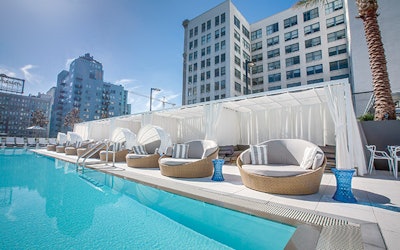
Whether we realize it or not, shade is one of the most important exterior design elements. It provides protection from the sun, shelter from rain and relief from the heat. Shaded areas are often the most popular gathering spots in the yard, garden, deck or patio, and structures that provide shade can be used as architectural or even sculptural design elements.
They can be simple and inexpensive or elaborate with costs that rival any other line item in a project. And making the shade can mean added revenue for builders or designers, much the way that patio furnishings bolster the bottom line. Shade is a natural companion to pools in particular and can be seamlessly incorporated into aquatic design schemes both visually and functionally.
Yet, for all of shade's importance, creative possibilities and revenue potential, it's still often an afterthought.
"I think a lot of pool builders are so busy focusing on the water they forget to look up and consider the possibilities above the ground," says Rick Chaffey, co-owner of Red Rock Contractors - Red Rock Pools and Spas in Gilbert, Ariz. "For whatever reason, builders are missing a huge opportunity, whether it's an elaborate structure or something as simple as an umbrella."
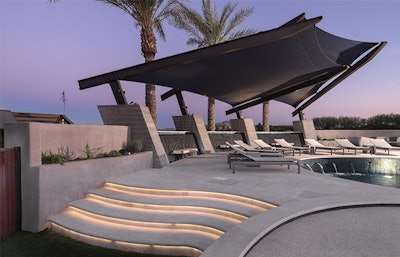 Photo courtesy of Shade Industries and Red Rock Pools and Spas
Photo courtesy of Shade Industries and Red Rock Pools and Spas
Chaffey reports that more than 80 percent of his company's projects include shade across a range of styles, expense and technical difficulty. For some projects, the treatment takes the form of a permanent structure that can be freestanding or attached to the house. In others it might be in the form of furnishings such as umbrellas or cabanas. For many designs, the shade is as much an architectural or even sculptural statement as it is a form of shelter.
"It's part of the overall trend toward designing and building the entire outdoor environment," Chaffey says. "There was a time when only the most sophisticated clients, mostly those who travel, would come to the process with detailed ideas about things like shade structures or other features. Now with the internet and all the resources people have, they come to the process more prepared. How you provide shade is a big part of that."
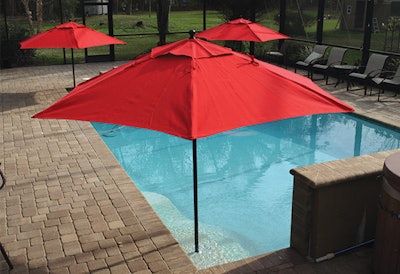 Umbrellas mounted in lounging shelves or beach entries have become a popular feature with many pool owners. Shading shallow waters is the primary focus of Fiberlite Umbrellas, which designs its fiberglass-framed umbrellas specifically for pool and spa use.
Umbrellas mounted in lounging shelves or beach entries have become a popular feature with many pool owners. Shading shallow waters is the primary focus of Fiberlite Umbrellas, which designs its fiberglass-framed umbrellas specifically for pool and spa use.
RELATED: What's a 'Pergola' Anyway?
CANOPY CLASS
As demand for different shade options has increased, a class of manufacturers specializing in various shade concepts has developed an increasingly varied set of products and design options.
One of those is ShadeFX, a custom manufacturer of retractable canopies and roofs based in Milton, Ont. Each system the company provides is designed for the specific project based on a variety of factors, including the size of the shaded area and how and when a shaded area will be used. ShadeFX canopies can be attached to existing structures or delivered as part of a kit that includes the structure itself, such as a freestanding pergola or patio cover.
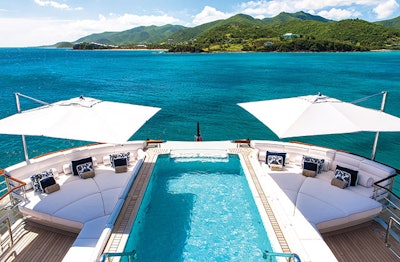 Whether it's cantilevered umbrellas on a luxury yacht or a retractable poolside canopy, designers and manufacturers alike draw inspiration from combining shade and water. (Photo courtesy of TUUCI)
Whether it's cantilevered umbrellas on a luxury yacht or a retractable poolside canopy, designers and manufacturers alike draw inspiration from combining shade and water. (Photo courtesy of TUUCI)
According to Marcio Miranda, sales and marketing director for ShadeFX, their success — and indeed, the growth of the entire shade industry — is ultimately driven by the basic human need to escape the sun or stay dry in the rain. "You can have a design that's fully fitted, but if you don't have a place to escape the elements, you can't really use your space much of the time," he says.
"For as important as it is," he adds, "often shade is ignored or it's an afterthought.
Professionals sometimes don't convey the value of shade protection to their customers, so it's one of the items that gets scratched when budgets are tight. Eventually, however, the customer will realize that when it rains or it's too hot outside, they can't enjoy their outdoor environment."
Miranda also points out that the demand for shade has also been bolstered by concerns over the damaging effects of UV rays. "We've noticed a trend where projects have requirements for certain fabrics because of the UV rating," he says. "It's a big issue now. There's a lot of information about the damage the sun's rays can cause on your skin and people are becoming more mindful of that."

By providing retractable systems, ShadeFX gives homeowners and commercial clients the option of covering up or letting the sun shine in. They provide a number of features, including remote-control apps and even wind sensors that will retract the canopy when the wind exceeds a preset speed. Because their canopies are as Miranda describes "visually minimal," they can be readily integrated to a variety of design schemes.
"Whether it's part of the original design, a large renovation, or an afterthought, we can always adapt to the setting," he says. "Every situation is different but we believe there's a growing recognition that people want and need shade. It's part of a fully fitted outdoor environment."
SETTING SAILS
One of the newer options, or at least one that many people are discovering these days, are shade "sails," which offer a distinct look while efficiently shading large areas.
Conrad Masterson, principal for Shade Industries in Phoenix, focuses largely on using sail shades, often covering part or all of a swimming pool. "Sails are both functional and beautiful," he says. "In practical terms, with tensioned fabric, which is what a sail really is, you can stretch fabric over distances that traditional structures would be cost prohibitive. If you need to cover an area over 30 with wood or steel, that's going to require a massive structure. With a sail you're covering that same area with fabric."
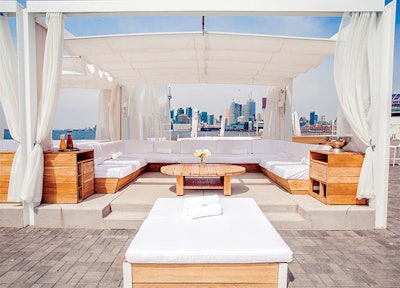
Masterson started in the shade business in 2003. Working in Arizona, he reports that without shade, a great many people would not be able to use their pools much of the time. "It's too hot," he says. "For much of the year, the only time you can use your pool is in the evening or early morning. Shade expands the time you can swim and keeps you more comfortable."
Although shade sails have been around since the 1980s, Masterson reports they've seen tremendous growth in the last few years due to their bold look, ability to cover large areas and creative application options.
"We're not limited by shape or size. We've spanned areas as long as 72 feet," he says. "And they look great! But as a company we're focusing mainly on the shade it's providing, the specific needs of the client. We discuss in great detail with our customers what areas they want to use, at what times of day, at what times of year for what types of functions? Are you barbecuing, are you sitting in the pool, are you swimming in the pool or are you relaxing at a table playing cards?"
All of those factors can impact the size, shape, location and orientation of the sail, he says. "We determine what it is you want to achieve and then we design the shade to meet that function. And, they do look great."
The sleek look is reminiscent of large sails on boats and ships and fits well with a range of architectural styles. Although fabric is by nature two-dimensional, Masterson reports that with proper positioning and combining more than one sail in some designs, he can create a look that appears three-dimensional.
"We try to pull the fabric into interesting shapes using high points and low points. Not only does that help create the shade you need, it can do other things like deflect the wind," he explains. "We're always trying to control the movement of the fabric in the wind; less movement will typically mean longer life."
The fabric Shade Industry uses in its sails is knitted high-density polyethylene material. It comes in a variety of colors. Although the fabric is not printable, per se, Masterson reports that it can be woven together to create patterns using different colored panels.
RELATED: 6 Trending Patios That Beat the Summer Heat in Style
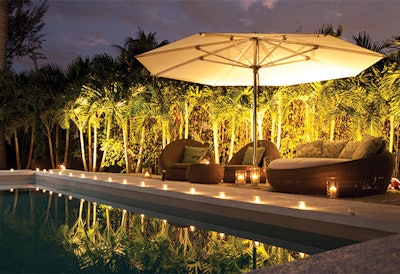
AND THE UMBRELLA
There's little question the venerable umbrella is the most familiar and commonly used type of shade structure. Handheld rain umbrellas and parasols have been a mainstay in multiple cultures for centuries. Beach umbrellas that stick directly in sand are often festooned with brilliant colors and are one of the truly iconic symbols of summer.
Larger picnic or market umbrellas mounted in the center of round or rectangular tables are similarly a staple of outdoor environments. These days, many swimming pools, particularly those with shallow lounging areas, have sleeves that support umbrellas, providing shade for in-pool lounging.
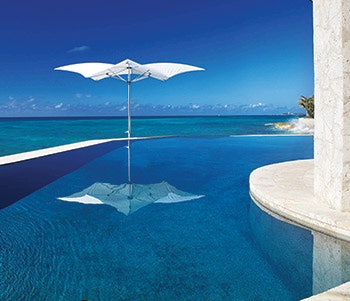 In addition to providing comfort and shelter, shade structures often dramatically enhance the aesthetic beauty of aquatic settings. Some even qualify as sculpture.
In addition to providing comfort and shelter, shade structures often dramatically enhance the aesthetic beauty of aquatic settings. Some even qualify as sculpture.
However they're used in the landscape, umbrellas are natural gathering places, hubs of activity as well as an attractive visual element that can be designed to harmonize with other features in the space.
As is true of other segments of the shade industry, umbrellas have also evolved, becoming larger with innovative, permanently mounted support systems and in some cases LED lighting, heating and even sound systems. In many cases, umbrellas are imprinted with logos for branding, especially in commercial settings.
TUUCI is a shade structure manufacturer based in Miami that offers a range of umbrellas that can fit to a spectrum of project types and budgets. The company also manufacturers cabanas, lounges, hammocks and sculptural shade structures, but umbrellas remain its primary focus. It's product line ranges from traditional umbrellas to those with cantilevered supports and dual umbrella designs across a range of colors and sizes.
According to Vannessa Cendan, TUUCI's marketing manager, "Umbrellas are an essential part for any outdoor space. It makes for a more comfortable experience whilst enjoying the outdoors. Most people will gravitate to a shaded area, therefore increasing demands for shade."
She sees tremendous potential for the shade market in general as consumers ask for more varied and often elaborate structures, and contractors recognize the opportunity to upsell. "We are always innovating and thinking of ways to grow our product offerings," she says. "We recently launched our new TUUCI Luna LED Light with innovative touch technology for our cantilever and MAX collection and the beautiful tilt feature for our cantilever products. This is one example of the many ways we are continuing to innovate with many more designs in the pipeline for 2018."
With so many design options fueled by increasing market momentum, perhaps it's time to consider shade structures in the same favorable light as outdoor kitchens, fire features and landscape lighting. After all, when the sun shines, there are both creative and financial opportunities waiting to be made in the shade.












































